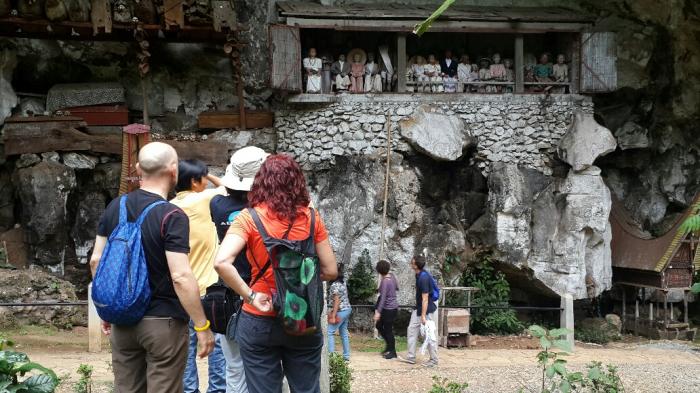
Introduction to Londa: A Resting Place Among the Rocks
Londa Cliffside Cemetery is one of the most mystical and sacred burial sites in Toraja, South Sulawesi. High in the lush highlands where mist weaves between terraced hills, this sepulchral wonder is hidden within nature’s architecture. Not merely a graveyard, Londa is a cavern of souls, etched into the face of a towering cliff. For the Torajan people, whose culture is intricately braided with rituals surrounding death, this site is hallowed ground. It is more than geography; it is memory carved into stone.
Toraja’s traditions are steeped in reverence for ancestors, and Londa embodies that spiritual devotion. This isn’t a silent place of mourning, but a sacred theatre where the past performs quietly, eternally.
The Ethereal Geography of Londa
Londa rests a short drive from Rantepao, nestled against dramatic limestone cliffs that seem to have been shaped deliberately for divine use. Nature here does not merely surround—it envelopes. The cliffside caves are carved deep into stone, yawning open like mouths ready to speak of lifetimes long gone.
As daylight slants into the caverns, coffins old and new emerge in chiaroscuro—a chiaroscuro not of paint but of life and death. Bats flicker in and out, and humidity clings like forgotten prayers. The terrain is treacherous in places, a metaphor for the narrow path between the living and the dead.
The Tau-Tau Effigies: Guardians of the Dead
Standing vigil over the cliffs are the Tau-Tau, wooden effigies of the deceased, carved with striking individuality. These figures, perched on balconies or peeking from ledges, are more than mere sculptures—they are sentinels. Their gaze follows visitors, watching not out of menace but memory.
Traditionally crafted to mirror the deceased’s likeness, Tau-Tau are a status symbol, reserved for the elite. Their presence signifies a respected soul, someone whose story deserves to be retold in wood. With arms outstretched or crossed in contemplation, these effigies become bridges between generations, whispering legacy to all who dare look up.
Burial Customs and Rituals of the Torajan People
In Torajan cosmology, death is not the end. It is transition. A Torajan funeral is not a somber affair but a cosmic celebration, often occurring months or even years after death. This waiting period allows families to gather resources for elaborate rituals, which may include the sacrifice of buffalo—symbols of passage into the afterlife.
Burials at Londa are not assigned arbitrarily. One must have social standing, ancestral rights, and familial connections. The higher one is buried in the cliff, the more elevated the soul is believed to be in the afterlife. Coffins, some centuries old, remain suspended or tucked into niches, weathered but dignified. Some hang precariously, a visual reminder of life’s fragile balance.
Echoes from the Past: Historical Relevance of Londa
Every creak of coffin wood and every faded carving within Londa tells a story. The oral histories of the Torajan people are echoed here in stone and bone. Elders recall names of those interred, tracing lineages back generations. In these caves, time softens, curling back on itself like smoke from ancestral incense.
The preservation of these ancient practices is not mere tradition—it is resistance to cultural erosion. Londa remains one of the few sites where visitors can witness an uninterrupted continuum of belief, where anthropology meets soulcraft. In fact, the UNESCO Intangible Cultural Heritage list recognizes the richness of Toraja funeral rites and their role in maintaining cultural identity across generations (UNESCO Source).
Londa Today: Between Pilgrimage and Tourism
As word of Londa’s mystique spreads beyond Sulawesi, the site has become a destination for both pilgrims and tourists. Visitors descend with smartphones and reverence in equal measure. Local guides, often descendants of the buried, offer insights that transcend guidebook summaries.
To help travelers explore Londa and other cultural landmarks with deeper understanding, Toraja Journey offers curated tour packages tailored to those who seek more than surface-level sightseeing. With knowledgeable local hosts and an emphasis on cultural respect, the platform bridges the gap between tradition and tourism, making your visit both meaningful and immersive.
Yet with visibility comes tension. The need to protect the sanctity of the dead clashes with the curiosity of the living. Photography is allowed, but with limits. Tourists are asked to tread not just carefully, but consciously—each step a small act of homage.
Reflections Amidst the Shadows
Standing in the penumbra of a coffin-laden cave, time feels irrelevant. One is struck not by morbidity, but by a profound tenderness—how carefully the dead are remembered, how lovingly they are watched over by their carved counterparts.
Londa does not ask for tears. It asks for awe. It beckons the living to look at death not as a void, but as continuation. In its haunting silence and chiseled grandeur, Londa offers a rare insight: that death, approached with ritual and love, is not something to fear, but something to honor.
Londa is not just where the Torajan dead reside. It is where their stories linger—etched in wood, stone, and eternal sky.
